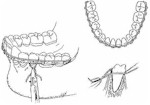|
Medical Education Division |
Operational Medicine 2001
Emergency War Surgery
Second United States Revision of The Emergency War Surgery NATO
Handbook
United States Department of Defense
Emergency War Surgery
Second United States Revision of The Emergency War Surgery NATO Handbook
United States Department of Defense
Home · Military Medicine · Sick Call · Basic Exams · Medical Procedures · Lab and X-ray · The Pharmacy · The Library · Equipment · Patient Transport · Medical Force Protection · Operational Safety · Operational Settings · Special Operations · Humanitarian Missions · Instructions/Orders · Other Agencies · Video Gallery · Phone Consultation · Forms · Web Links · Acknowledgements · Help · Feedback
|
Emergency War Surgery NATO Handbook: Part IV: Regional Wounds and Injuries: Chapter XXIII: Maxillofacial Wounds and Injuries Fracture ManagementUnited States Department of Defense After conservative debridement of bone fragments has been completed, any remaining exposed bone must be covered by soft tissue. A mandibular stump can be covered by suturing mucous membrane to the skin edge. If the oral cavity has not been excluded by watertight closure, the fracture site must be drained to the exterior for 2 - 5 days. Only teeth which are completely loose or fractured teeth with exposed pulp should be removed. Firmly embedded teeth are left in situ, even if they are near fracture lines. Damaged teeth are useful for immobilization of fractures. Residual molar teeth in otherwise edentulous jaws are especially valuable for fixation. Although dead, carious, or loose teeth may cause infection, they should not be disturbed at this time. Immobilization of the jaws is necessary for accurate reestablishment of occlusion as well as early union of fractures. It also facilitates the healing of soft-tissue wounds, limits the spread of infection, and prevents deformity. Several methods of immobilization of the jaws are practical, as follows:
Approved for public release; Distribution is unlimited. The listing of any non-Federal product in this CD is not an endorsement of the product itself, but simply an acknowledgement of the source. Operational Medicine 2001 Health Care in Military Settings
This web version is provided by The Brookside Associates Medical Education Division. It contains original contents from the official US Navy NAVMED P-5139, but has been reformatted for web access and includes advertising and links that were not present in the original version. This web version has not been approved by the Department of the Navy or the Department of Defense. The presence of any advertising on these pages does not constitute an endorsement of that product or service by either the US Department of Defense or the Brookside Associates. The Brookside Associates is a private organization, not affiliated with the United States Department of Defense. |
